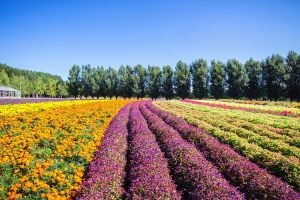
Ethiopia is generally recognized as the birthplace of coffee, specifically the Coffee Arabica species, which is the prime one to the universal coffee industry.
Zekarias Shiferaw, Agricultural economist, says, “Not only is coffee production in Ethiopia a vital part of our economy, but it is also a significant aspect of cultural heritage across the nation. Ethiopia stands first in Africa and third in the world in terms of production while fifth as an exporter of Arabica coffee.
Ethiopia is the third-largest Arabica coffee producer in the world, next to Brazil and Colombia. The coffee industry in Ethiopia is the driving force of the country’s economy, socio-cultural and spiritual life of the people. Ethiopian coffee is produced through three main systems; of course, forest coffee, garden coffee and plantation coffee.”
Undeniably, the coffee industry provides a job opportunity and a livelihood for millions of farmers and it is important for industries involved in its roasting, mixing and packaging. Ethiopia, being the origin and the center of genetic diversity of Arabica coffee, is the largest producer, exporter and consumer of coffee in Africa, Zekarias added.
As to him, coffee has also played an important role in the sociocultural life of many people in Ethiopia. For example, the coffee drinking ceremony after certain sociocultural events such as marriage arrangement and dispute settling is often considered as approval for these events.
“Coffee in Ethiopia is produced under four different production systems, namely forest, semi-forest, garden and plantation coffees, which vary in their level of management from little or none in the forest coffee to intensive in the plantation coffee, and in four coffee-growing regions, namely Eastern or Harar, Southern, Southwestern and Northwestern regions, which vary in their growing environment, coffee production system or both. Forest coffee is a naturally regenerated and unmanaged (little managed) coffee grown under natural forests.”
Semi-forest coffee is a dominant production system in the Southwestern region. It is either an intensively managed forest coffee like clearing of plants competing with coffee, reducing the large canopy trees to open up the canopy, protecting and thinning of naturally regenerated coffee seedlings and planting coffee seedlings in open areas or a traditionally managed planted coffee in natural forests.
Plantation coffee (mainly found in the Southwestern region) is a coffee production system wherein improved varieties and agronomic practices, such as seed preparation, nursery management, plant spacing, mulching, weeding, fertilizer and herbicide application and pruning, are usually used.
The impact of climate change on coffee production in Ethiopia, in addition to the commonly known production constraints of coffee in the country, such as traditional cultivation practices and diseases, is so immense unless handled carefully. The processing methods also vary, with traditional dry processing enhancing fruity flavors, while washed methods highlight the coffee’s delicate floral notes.
Ethiopian coffee industry is a blend of rich history, cultural significance, and economic importance. The country’s unique production methods and diverse flavor profiles make Ethiopian coffee highly sought after in the global market, ensuring its place as a cornerstone of both local and international coffee culture.
Yes, farming adaptations could ensure resilience and improve productivity. These adaptions include irrigation to maintain soil water, tree shade management to protect forest cover, mulching to better soil fertility, terracing to improve soil quality and reduce water run-off, and pruning to maximize crop potential.
This significant milestone was highlighted during a national coffee exhibition and awareness forum held today at the Ethiopian Science Museum. The premier pointed out that Ethiopia has experienced a remarkable increase in revenue from coffee exports, reaching over 1.4 billion USD in the last fiscal year. He attributed this growth to ongoing improvements in the macroeconomic environment and the coffee trade sector.
He further noted the importance of collaboration with stakeholders, including farmers, cooperatives, and regional communities, aimed at promoting awareness and implementing best practices in coffee cultivation. By maintaining this strength, farmers and coffee traders are encouraged to support the plans we have laid out. The work you have done in the past years is remarkable.
The impact of climate change on coffee production are multifaceted ranging from diminishing suitable land, increased prevalence of pests, reduced quality, and indirectly through biodiversity loss. Rising temperatures and erratic rainfall patterns affect coffee production through two primary channels.
The geographic shift in coffee production presents several challenges. Many current coffee growers, whose livelihoods depend almost exclusively on coffee, will need to either relocate to higher elevations or transition away from coffee cultivation. Relocation involves non-economic costs and requires substantial coordination and funding. Farmers in areas becoming suitable for coffee must decide whether to continue with their current crops or switch to coffee. If they choose coffee, they will need to acquire financial resources and skills for coffee cultivation, production, storage, and marketing.
Additionally, due to coffee’s perennial nature (5-6 years between planting and first harvest), new entrants would need alternative income sources until their first harvest. Whether these transitions occur depends on the costs of transition and adjustment, which are expected to be high, given the small-scale nature of production.
The evolving landscape of coffee production due to climate change poses significant adaptation and mitigation challenges for farmers, whether they are exiting or entering coffee cultivation. For those exiting, switching to other crops or occupations or relocating to higher altitudes are feasible but costly medium- to long-term adaptation strategies. New entrants face hurdles such as acquiring the necessary coffee management skills and making substantial investments to switch from other crops. This transition requires significant investment, coordination, and funding. Research is essential to determining the best ways to support mobility and new farmers.
Given the long lead times in tree crops, further research and stakeholder engagement on adaptation and mitigation mechanisms are crucial. This includes research on improving access to finance for climate change adjustment and developing resilient coffee varieties. Additionally, supporting coffee farmers by introducing coffee varieties resilient to pests, droughts, and changes in soil; new technologies including shading, composting, and mulching; and advanced pest management and complementary investments are necessary to enhance resilience.
Coffee production is significant, especially in developing nations, as it’s a major source of income and livelihoods for millions, contributing significantly to national economies and global trade. It also plays a role in job creation and food security.
Coffee cultivation is a primary source of income for millions of smallholder farmers and their families in countries like Ethiopia, Brazil, and Vietnam. Coffee is a major export commodity for many countries, generating significant foreign exchange earnings. For example, in Ethiopia, coffee contributes around 30-35% of foreign income.
The coffee industry creates jobs not only in farming but also in processing, transportation, and retail sectors. Coffee is one of the most significant agricultural commodities in the world, with a market value of over $200 billion. Coffee farming can contribute to food security in some regions by providing income for families to purchase food. The coffee industry can support community development by providing employment and income opportunities.
Initiatives like “business with positive social impact” aim to improve conditions for farmers and ensure sustainable production.
Coffee plays a significant role in the culture and traditions of many coffee-growing regions. Coffee cultivation can contribute to the preservation of ecosystems, especially when practiced sustainably. Sustainable coffee production can help mitigate climate change by promoting afforestation and carbon sequestration.
To boost coffee production, focus on improving coffee plant health, implementing sustainable farming practices, and utilizing appropriate technologies like improved varieties and pruning techniques, while also addressing climate change impacts.
Ethiopia has made continuous efforts to enhance the production, productivity and quality of its coffee. Yet, comprehensive data on these issues are scant.
Ethiopia has suitable environments for coffee production and it produces different coffee types in different coffee growing regions. Coffee in Ethiopia is the most important source of foreign currency earnings for the country and cash incomes for the coffee producing farmers. It is often said that the Ethiopian coffee is low in production, productivity and quality, and varied in quality with growing region/area.
Cultivation area, production, productivity and quality of coffee in Ethiopia show different patterns over time. The coffee production improvement project in Ethiopia also needs to target more on productivity improvement than expanding plantations since the latter can lead to deforestation and competition for land.
BY MENGESHA AMARE
THE ETHIOPIAN HERALD FRIDAY 11 APRIL 2025





